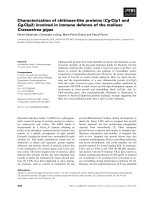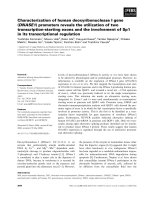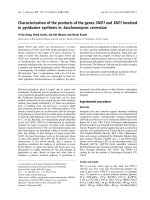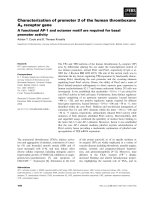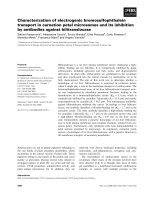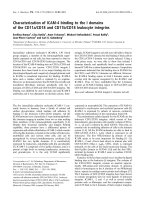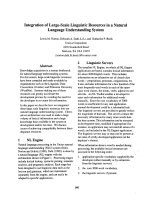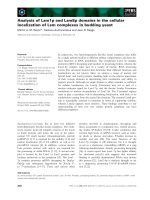Báo cáo khoa học: Characterization of structural and catalytic differences in rat intestinal alkaline phosphatase isozymes pdf
Bạn đang xem bản rút gọn của tài liệu. Xem và tải ngay bản đầy đủ của tài liệu tại đây (526.15 KB, 10 trang )
Characterization of structural and catalytic differences
in rat intestinal alkaline phosphatase isozymes
Tsuyoshi Harada
1
, Iwao Koyama
1
, Toshiyuki Matsunaga
1
, Akira Kikuno
1
, Toshihiko Kasahara
1
,
Masatoshi Hassimoto
1
, David H. Alpers
2
and Tsugikazu Komoda
1
1 Department of Biochemistry, Saitama Medical School, Saitama, Japan
2 Division of Gastroenterology, Washington University School of Medicine, St Louis, MO, USA
Alkaline phosphatases (EC 3.1.3.1) (APs) are dimeric
metalloenzymes that catalyze the hydrolysis of phos-
phate monoesters into inorganic phosphate [1]. The two
Zn
2+
and one Mg
2+
ligand combination at the catalytic
site of APs is largely conserved from Escherichia coli
(E. coli) to humans and is essential for enzymatic
Keywords
3D modeling; intestinal alkaline
phosphatase; isozyme; rat; zinc
Correspondence
T. Komoda, Department of Biochemistry,
Saitama Medical School, 38 Morohongo,
Moroyama-machi, Iruma-gun, Saitama
350–0451, Japan
Fax: + 81 492 76 1155
Tel: + 81 492 76 1155
E-mail:
(Received 4 December 2003, revised 15
February 2005, accepted 17 March 2005)
doi:10.1111/j.1742-4658.2005.04668.x
To understand the differences between the rat intestinal alkaline phospha-
tase isozymes rIAP-I and rIAP-II, we constructed structural models based
on the previously determined crystal structure for human placental alkaline
phosphatase (hPLAP). Our models of rIAP-I and rIAP-II displayed a typ-
ical a ⁄ b topology, but the crown domain of rIAP-I contained an additional
b-sheet, while the embracing arm region of rIAP-II lacked the a-helix,
when each model was compared to hPLAP. The representations of surface
potential in the rIAPs were predominantly positive at the base of the active
site. The coordinated metal at the active site was predicted to be a zinc
triad in rIAP-I, whereas the typical combination of two zinc atoms and
one magnesium atom was proposed for rIAP-II. Using metal-depleted
extracts from rat duodenum or jejunum and hPLAP, we performed enzyme
assays under restricted metal conditions. With the duodenal and jejunal
extract, but not with hPLAP, enzyme activity was restored by the addition
of zinc, whereas in nonchelated extracts, the addition of zinc inhibited duo-
denal IAP and hPLAP, but not jejunal IAP. Western blotting revealed that
nearly all of the rIAP in the jejunum extracts was rIAP-I, whereas in duo-
denum the percentage of rIAP-I (55%) correlated with the degree of AP
activation (60% relative to that seen with jejunal extracts). These data are
consistent with the presence of a triad of zinc atoms at the active site of
rIAP-I, but not rIAP-II or hPLAP. Although no differences in amino acid
alignment in the vicinity of metal-binding site 3 were predicted between the
rIAPs and hPLAP, the His153 residue of both rIAPs was closer to the
metal position than that in hPLAP. Between the rIAPs, a difference was
observed at amino acid position 317 that is indirectly related to the coordi-
nation of the metal at metal-binding site 3 and water molecules. These find-
ings suggest that the side-chain position of His153, and the alignment of
Q317, might be the major determinants for activation of the zinc triad in
rIAP-I.
Abbreviations
AP, alkaline phosphatase; BAC, base of the active site cleft; CB, carbonate-bicarbonate; DM, double mutant; ECAP, Escherichia coli alkaline
phosphatase; GCAP, germ cell-type alkaline phosphatase; hPLAP, human placental alkaline phosphatase; IAP, intestinal alkaline
phosphatase; M1, metal-binding site 1; M2, metal-binding site 2; M3, metal-binding site 3; PLAP, placental alkaline phosphatase; rIAP,
rat intestinal alkaline phosphatase; SAP, shrimp alkaline phosphatase; TNAP, tissue-nonspecific alkaline phosphatase.
FEBS Journal 272 (2005) 2477–2486 ª 2005 FEBS 2477
activity [2]. In E. coli, the Zn
2+
ion at metal-binding
site 2 (M2) activates the hydroxyl group of Ser102,
which performs a nucleophilic attack on the phosphate
moiety of the substrate, resulting in a covalent phos-
phoseryl intermediate [3]. A water molecule, activated
by the Zn
2+
ion at metal-binding site 1 (M1), hydro-
lyzes this intermediate via a noncovalent enzyme–phos-
phate complex. This phosphate moiety is then released
from the complex and the enzyme returns to its free
state. Thus, of the three metal ions found at the active
site, the two Zn
2+
ions are thought to play important
roles in catalysis. The role of the Mg
2+
ion at metal-
binding site 3 (M3), however, is unclear. A recent
study indicated that this Mg
2+
ion affects the orienta-
tion of Ser102, which alters the protein conformation
near the Zn
2+
ion at M2 [4].
A mutated E. coli AP (ECAP), containing a triad of
Zn atoms at its active site, has been shown to be less
active than the wild-type AP [5], and green crab and
bovine kidney AP activity were reported to be inhib-
ited by sufficient concentrations of Zn
2+
, possibly by
the displacement of Mg
2+
from its active site [6,7].
Bovine milk AP activity markedly decreased when the
Mg
2+
ion at its active site was replaced by Zn
2+
[8],
and a number of APs require the addition of Mg
2+
to
achieve maximum activity.
Others have proposed that the first duplication of
the ancestral AP gene during the evolution of the AP
gene family produced a tissue-nonspecific type AP
(TNAP) and that subsequent duplications gave rise to
further modifications, resulting in tissue-specific APs
such as intestinal-type AP (IAP), placental-type AP
(PLAP), and germ cell-type AP (GCAP) [9,10]. No
tissue-specific APs have, to date, been found in inver-
tebrates. IAP was a late development in the AP gene
family, appearing for the first time in mammals [10];
IAP is represented by a single protein in most mam-
mals, although two IAP genes have been isolated in
the rat and four IAP genes have been isolated in the
cow [11,12]. Neither PLAP nor GCAP isozymes have
been detected in rodents, and rat IAPs (rIAPs)
appear to be the sole tissue-specific isozymes in rats
[10,13]. However, no significant preference for differ-
ent substrates has been noted between the rIAP iso-
zymes.
Recently, the presence of a Zn triad at the active site
of shrimp AP (SAP) was confirmed by the analysis of
its 1.9 A
˚
crystal structure [14]. Furthermore, the sensi-
tivity of rat AP isozymes for Zn
2+
has been reported
to differ, in particular, the AP activity from the small
intestine is not decreased by exogenous Zn
2+
[15].
However, the presence of a Zn triad at an AP active
site has never been demonstrated in mammals.
In this study, we used the swiss-model program to
construct 3D models of rIAP-I and rIAP-II; we then
analyzed the active site of the enzymes and studied the
effect of various combinations of metals at the active
site. The models showed the possibility of a Zn triad
at the metal-binding positions of the active site in
rIAP-I. We also investigated whether the activity of
metal-complemented rIAPs was stimulated by Zn
2+
.
Results
The sequence alignment of rIAP-I and human PLAP
(hPLAP) acquired using blast showed 75% identity
and 85% homology, with no insertions or deletions
relative to hPLAP. The sequence alignment of rIAP-II
and hPLAP revealed 77% identity and 87% homo-
logy, with no insertions but the deletion of one residue
relative to hPLAP.
The structure of rIAP-I was predicted based on the
structures of hPLAP, SAP, and the ECAP mutant
(PDB entry codes: 1EW2, 1K7H, and 1KHJ, respect-
ively) using the swiss-model program, and the struc-
ture of rIAP-II was predicted based on the structures
of hPLAP, SAP, and two ECAP mutants (PDB entry
codes: 1EW2, 1K7H, 1KHK, and 1KHL, respectively).
The stereochemical parameters, main-chain parame-
ters, and side-chain parameters (checked using pro-
check) were within the allowable range for both
rIAP-I and rIAP-II. A Ramachandran plot showed
that 86.0% of the residues lay in the most favoured
regions, 11.8% in additionally allowed regions, 1.7%
in the generously allowed regions, and 0.5% in the
disallowed regions of rIAP-I, with values of 87.2%,
11.4%, 1.2%, and 0.2% for the corresponding regions
of rIAP-II.
After the models had been cleaned up by using pro-
check, most of the overall structure of rIAP-I and
rIAP-II was consistent with the structure of hPLAP
(Fig. 1A) [16]. Each model showed a typical a ⁄ b topol-
ogy, with a central 10 b-sheet sandwiched between a
set of helices. The rIAP-I isozyme was composed of 23
a-helices and 14 b-sheets, whereas rIAP-II was com-
posed of 22 a-helices and 15 b-sheets. In addition to
the a-helices of PLAP, residues 469–471 (468–470 in
rIAP-II, because of the deletion of a single residue at
401) at the carboxy terminus formed a helix in both
rIAPs, but the a-helix between residues 277–279
formed a turn in rIAP-II. The b-sheet (423–425) in the
crown domain of PLAP formed a coil in rIAP-I
(Fig. 1A).
Examination of the electrostatic potential of the act-
ive site revealed that the base of the active site cleft
(BAC) was clearly positively charged on the surface of
Divergences of rat alkaline phosphatase isozymes T. Harada et al.
2478 FEBS Journal 272 (2005) 2477–2486 ª 2005 FEBS
the rIAPs (Fig. 1B). The edge of the BAC in hPLAP
was constructed from Phe107, Gln108, Arg166,
Asn167, and Tyr367. Residue differences at the BAC
of the rIAPs consisted of Tyr107 and Lys108, with the
addition of Asp167 in rIAP-I.
The rIAP-II model contained a Zn ion at posi-
tions M1 and M2, respectively, and a Mg ion at
M3, as in hPLAP, whereas that of rIAP-I contained
a Zn ion at M1, M2, and M3. As rIAP-I was not
suited to interact with the Mg ion at M3, the active
site of the rIAP-I model was completely occupied by
Zn ions. A comparison of the residues serving as the
ligand for the M3 metal ion is shown in Table 1.
The residues of the direct ligands to the metal were
the same as in hPLAP, but those of indirect ligands,
which bind the metal through water molecules, were
different at residue 317 (Gln in rIAP-I and Arg in
rIAP-II).
A
B
Fig. 1. Comparison of the overall structures of monomeric rat intestinal alkaline phosphatases (rIAPs). (A) The overall structure of the mono-
meric rIAPs and human placental alkaline phosphatase (hPLAP) is represented by ribbons, with the a-helix in red and the b-sheet in light blue.
Differences between the APs are indicated by asterisks. The a-helix of the carboxyl terminal is denoted by the orange asterisk; the crown
domain region is shown by the yellow asterisk, and the embracing arm is shown by the pink asterisk. (B) Representation of surface potential,
prepared using
GRASP. The potentials range from negative, in red ()25), to positive, in blue (+ 25). The active site is circled in yellow.
T. Harada et al. Divergences of rat alkaline phosphatase isozymes
FEBS Journal 272 (2005) 2477–2486 ª 2005 FEBS 2479
rIAP-I and rIAP-II are expressed in the duodenal
mucosa, but the jejunal mucosa only expresses the
rIAP-I isozyme [17,18]. We assayed the AP activity of
duodenum and jejunum mucosal extracts in a standard
buffer supplemented with 1 mm Zn (Fig. 2A). The exo-
genous excess of Zn
2+
had no effect on the AP activity
in the jejunal extract. A buffer containing 1 mm Zn
and 1 mm Mg inhibited the duodenal AP activity by
41% and the hPLAP activity by 33%. Under metal-
free conditions, with no metals in the samples or in the
assay buffer, the AP activity of the duodenal and
jejunal extracts and of hPLAP was 90% lower than
the activity in nonchelated samples (Fig. 2B). Metal-
chelated samples from the small intestine, but not of
hPLAP, were activated by 1 mm Zn under Mg-free
conditions, but duodenal activation was only 60% of
the degree of activation seen using jejunal extracts.
The metal-chelated sample of hPLAP was not activa-
ted by the addition of exogenous Zn
2+
alone. The
presence of Mg
2+
was required to obtain maximum
activity in all the metal-chelated samples. When the
metal-chelated samples were assayed in an assay buffer
containing 1 mm Mg and 20 lm Zn, the activity levels
recovered to 60–70% of the level in nonchelated
extracts (data not shown).
The percentage of rIAP isozymes in both duodenum
and jejunum was examined by Western blotting (Fig. 3).
In the jejunum, one rIAP band, with an apparent
molecular mass of 70 kDa, was present, but two bands
of 88 kDa and 75 kDa were detected as rIAP-II and
rIAP-I in the duodenum. The molecular mass values
of the rIAPs were similar to those of previous reports
[19,20]. When the quantitative ratio of the rIAPs was
determined using densitometry, 96% of the IAPs in
the jejunum were identified as rIAP-I. In the duo-
denum, the proportion of rIAPs was 55% and 45%
for rIAP-I and rIAP-II, respectively. The 55% contri-
bution of rIAP-I to total IAP activity correlates almost
exactly with the observation that Zn
2+
supplementa-
tion in metal-chelated conditions activates duodenal
AP to a level that is 60% of that seen with jejunal
extracts (Fig. 2B). These data suggest that the finding
of Zn
2+
inhibition without metal chelation and of
Zn
2+
activation with metal chelation (Fig. 2) can be
explained by the proportion of rIAP-I in the duodenal
and jejunal extracts.
Most of the active-site residues in APs have been
perfectly conserved throughout evolution [21]. In view
Fig. 2. Effect of zinc on alkaline phosphatase activity. Each of the
extracts was adjusted to an activity level of between 200 IUÆmL
)1
and 400 IUÆmL
)1
by dilution with carbonate-bicarbonate (CB) buffer
prior to use in the assay. The assay was performed using non-
chelated (A) and chelated (B) extracts. The relative activity is the
proportion of the residual activity compared with that in nonche-
lated extracts assayed in a CB buffer containing 1 m
M Mg. Each
value for the rat duodenal and jejunal extracts represents the
mean ± SD of data from four animals.
Table 1. Distances (A
˚
) between the residues and the metal at
metal-binding site 3 (M3). hPLAP, human placental alkaline phos-
phatase; rIAP, rat intestinal alkaline phosphatase.
Residue Element hPLAP rIAP-I rIAP-II
D42 OD2 2.35 2.52 2.53
H153 NE2 4.95 2.40 2.72
S155 OG2 2.45 2.46 2.43
E311 OE1 ⁄ OE2
a
2.30 3.27 3.20
a
Distances were calculated between OE1 and the metal in hPLAP,
and between OE2 and the metal in the rIAPs. The metal position
was based on the M3 position of hPLAP.
Divergences of rat alkaline phosphatase isozymes T. Harada et al.
2480 FEBS Journal 272 (2005) 2477–2486 ª 2005 FEBS
of the Zn
2+
activation of rat APs, we further exam-
ined the M3-related residues (Table 2). No differences
among residues that directly interact with the metal at
the M3 site were found in mammalian tissue-specific
APs, but a specific difference in ligands with an indi-
rect interaction was observed: Gln317 in rIAP-I, and
Arg317 in rIAP-II. The His317 of hPLAP is known to
be indirectly associated with the M3 site and to main-
tain the Mg ion at this site via a water molecule [16].
Comparative stereoviews of the M3 site residues in
the active site are shown in Fig. 4. Mg
2+
at the M3
site is coordinated octahedrally with three residues and
three water molecules, i.e. the OD2 oxygen atom of
Asp42, the OG2 oxygen atom of Ser155 (Thr155 in
E. coli), and the OE1 oxygen atom of Glu311 in
hPLAP [16,22]. The positions of Asp42, Ser155, and
Glu311 did not vary significantly from their positions
in the side-chains of hPLAP. His153 was clearly closer
to the metal position in rIAP than in hPLAP. A com-
parison of the distances between the residues and the
metal revealed that His153 was the closest residue to
the metal at 2.40 A
˚
in rIAP-I and was closer to the
metal than Glu311 in rIAP-II (Table 1). Because of
these differences in the side-chain structure, the posi-
tion of the water-interacting atom, i.e. a nitrogen atom
of Gln317 in rIAP-I and a nitrogen atom of Arg317 in
rIAP-II, was also different from that in hPLAP.
Discussion
The rat duodenal mucosa contains two types of rIAP
mRNA (a 2.7 kb mRNA and a 3.0 kb mRNA) that
encode different rIAP genes – rIAP-I and rIAP-II,
respectively [11,23]. The rIAP-I gene is expressed in
both duodenal and jejunal mucosa, whereas the rIAP-
II gene is expressed only in duodenal mucosa [17,18].
Differences in substrate preferences and kinetic param-
eters have been observed between these two isozymes
[17,18]. The expression of these isozymes responds
differently to fat feeding, 1,25-dihydroxyvitamin D
3
,
cortisone, and lipopolysaccharide [18,24–27]. However,
Table 2. Residues constituting metal-binding site 3 (M3). The resi-
due numbers correspond to the human placental alkaline phospha-
tase (hPLAP) sequence number. H153 and H317 in hPLAP are
homologous to D153 and K328 in Escherichia coli and to H149 and
H316, respectively, in shrimp AP. The alkaline phosphatase (AP)
abbreviations are as follows: ECAP, E. coli AP; hGCAP, human
germ cell AP; hIAP, human intestinal alkaline phosphatase; hTNAP,
human tissue-nonspecific AP; mIAP, mouse IAP; mTNAP, mouse
tissue-nonspecific AP; rIAP, rat intestinal alkaline phosphatase;
rTNAP, rat tissue-nonspecific AP; SAP, shrimp AP.
Residues at M3
Direct Indirect
a
42 155 311 153 316 317
rIAP-I D S E H D Q
rIAP-II D S E H D R
ECAP D T E D D K
SAP D T E H D H
rTNAP D T E H D H
mTNAP D T E H D H
hTNAP D T E H D H
mIAP D S E H D R
hIAP D S E H D H
hGCAP D S E H D H
hPLAP D S E H D H
a
Residues indirectly associating with the metal via water mole-
cules.
A
B
Fig. 3. Immunological detection of rat intestinal alkaline phospha-
tase (rIAP) isozymes in rat small intestine. Western blotting was
performed, using an antiserum against rat IAP, in duodenal and jej-
unal mucosa extracts. (A) The same extracts (2 lL) used for the AP
activity assay in Fig. 2A were applied to SDS ⁄ PAGE and blotted, as
described in the Experimental procedures. This representative pho-
tograph shows the results for one of the four animals that were
examined. (B) The abundance of rIAP isozymes in rat small intes-
tine was determined by zone densitometry. The data represent the
mean ± SD of four experiments.
T. Harada et al. Divergences of rat alkaline phosphatase isozymes
FEBS Journal 272 (2005) 2477–2486 ª 2005 FEBS 2481
the physiological role and expression of two isozymes
in the same organ, particularly when their physiologi-
cal substrates differ, is not clear.
rIAPs, as well as other mammalian APs, possess
additional secondary structural elements compared
with ECAP, such as: N-terminal a-helices; an embra-
cing arm region (residues 208–280) that connects with
other monomers; a noncatalytic metal-binding site;
and the ‘crown domain’ (residues 366–430) [16]. A site
for collagen attachment has been localized in the loop
comprising residues 405–435 in the crown domain of
TNAP [28]. When the TNAP gene is inactivated and
the crown domain is lost, the disorder that results
(hypophosphatasia) is characterized by poorly mineral-
ized bone [29–31]. This crown domain allows mamma-
lian APs, which act as monoester phosphohydrolases,
to display a substrate preference. The embracing arm
region has been reported to be important in joining
the two AP monomers of AP together [32]. In a vari-
ety of human cancer cell lines and sera, the Kasahara
AP isoform has been found to consist of heterodimers
of hIAP and hPLAP [33,34], and the human postnatal
intestine also contains heterodimers of hIAP and
hPLAP [35]. Ovarian cancer cells and cell lines derived
from these cells express heterodimers of hPLAP and
hGCAP [36–38]. While no heterodimers of rIAP-I and
rIAP-II have been detected in rats, they must have an
important role in the identification of each isozyme to
form a homodimer in the same organ. The structural
differences between rIAPs observed in the crown
A
B
Fig. 4. Stereoviews of the residues near metal-binding site 3 in (A) rat intestinal alkaline phosphatase-I (rIAP-I) and (B) rIAP-II. The white resi-
dues represent those seen in human placental alkaline phosphatase (hPLAP), and the orange sticks with red tips represent PO
4
. The posi-
tions of the metal, represented by a brown sphere, and of PO
4
, were constructed based on data for hPLAP (PDB code: 1EW2).
Divergences of rat alkaline phosphatase isozymes T. Harada et al.
2482 FEBS Journal 272 (2005) 2477–2486 ª 2005 FEBS
domain and the embracing arm are clues to the
physiological and functional differences between these
two rIAP isozymes.
The base of the active site in rIAPs is a more clearly
positively charged patch than that in hPLAP, and
ECAP does not exhibit this positivity. As a result, neg-
atively charged substrates, such as phosphomonoesters,
are drawn strongly towards the active site. Mammalian
APs have 10–100-fold higher k
cat
values than bacterial
APs, and IAP has the highest specific activity of all
human and rat APs [39,40]. The surface charge of this
region must be partly responsible for its activity. A
similar observation has been made in regard to SAP,
and the surface charge of SAP is thought to optimize
the direction of the substrate to the active site in cold
(5 °C) environments [14].
One of the striking findings of this study was that
exogenous Zn
2+
can restore the activity of metal-
chelated rIAP, but not that of hPLAP, as predicted
using a 3D-model. A number of mammalian APs are
thought to require the presence of Mg
2+
to achieve
maximal activity. An excess of Zn
2+
inhibits the activ-
ities of AP in all tissues, and this inhibition is attrib-
uted to the displacement of Mg
2+
from its M3 site by
Zn
2+
[1,7,8]. Hung & Chang [41] showed that the con-
formation of Zn
2+
at the M3 site is unfavorable for
catalysis in hPLAP and that both Mg
2+
activation
and Zn
2+
inhibition of AP are reversible processes. In
the rat, Andeniyi & Heaton [15] reported that the
addition of Zn
2+
(0.01 mm) decreased the activity of
TNAP isolated from the liver and the kidney, but
increased the activity of AP isolated from the small
intestine. These findings are consistent with the con-
cept that the IAP isozyme binds Mg
2+
at the M3 site
more strongly than TNAP and hPLAP [1,15,21]. Based
on our results, we speculated that the rIAPs, partic-
ularly rIAP-I, are activated by Zn
2+
, even if Zn
2+
occupies all three metal-binding sites. Thus, Zn
2+
can
act as a catalytic coordinator at the M3 site of rIAP-I.
Catalytic differences in metal preferences between
rIAPs and hPLAP may reflect the subtle coordination
of amino acids constructing the M3 space. No differ-
ences in amino acid alignment have been observed
between SAP and rTNAP, yet Zn
2+
and Mg
2+
are
preferentially selected at the M3 sites, respectively [14].
The wild-type hPLAP favors Mg
2+
at the M3 site, but
the Chelex-treated mutant Gly429 hPLAP can be acti-
vated by low concentrations (0.5–20 lm)ofZn
2+
[41,42]. Mg
2+
coordination at the M3 site can be des-
cribed as a slightly distorted octahedron involving the
OD2 oxygen atom of Asp42, the OG2 oxygen atom of
Ser155, the OE1 oxygen atom of Glu311, and three
water molecules. The structure of hPLAP indicates
that His153, while coordinated with a water molecule
at the M3 site, is too far from the Mg
2+
at the M3 site
to function as a ligand for the M3 metal [16]. Metal
specificity can be altered by a single amino acid substi-
tution, and the X-ray structure of a mutant ECAP, the
D153H mutant enzyme, showed that the replacement
of Asp153 with histidine changed the metal at the M3
site from an octahedrally coordinated Mg
2+
in the
wild-type structure to a tetrahedrally coordinated zinc;
the K328H mutant and the double mutant D153H ⁄
K328H (DM) enzyme also contained a Zn triad at their
active sites [5,43,44]. Sequence alignments showed that
this histidine residue is conserved in mammalian
sequences, including hPLAP, although a Mg ion is
reported to occupy this site [16]. The side-chain of
His153 in D153H and DM_ECAP is sufficiently close
to be a direct ligand of the metal; thus, the metal
coordination changes from octahedral to tetrahedral [5].
In addition to the distance between the metal posi-
tion at M3 and His153, His317 is also important for
coordinating the water molecule that interacts with
Mg
2+
at the M3 site and with the phosphate group.
When His317 in hPLAP was mutated to Ala317, the
mutant enzyme had higher k
cat
and K
m
values than
the wild-type hPLAP [21]. This finding indicates that
the disruption of the water molecule results in an
enzyme with a lower affinity for both its substrate and
its products and that affects the interaction between
the phosphate group and the water molecule. All
mammalian APs discovered to date, except for the
rIAPs and mouse IAP (mIAP), possess His317 (rIAP-I
contains Q317, while rIAP-II and mIAP contain R317)
[11]. We confirmed that a jejunal homogenate, rIAP-I,
had a higher sensitivity to Zn
2+
activation. Therefore,
the Q317 of rIAP-I may affect the water molecule in a
manner that enables the water molecule to interact
with the phosphate residue and catalyze the substrate
in the presence of a Zn triad.
In conclusion, this structural analysis of rIAPs
revealed important differences that may provide clues
regarding the physiological role of phosphate monoest-
erases in the small intestine. We confirmed that when a
Zn triad is present at the active site, rIAP-I can be
activated under Mg-free conditions. We speculate that
the dephosphorylation targets of rIAP-I and rIAP-II
may differ. Furthermore, we demonstrated that rIAP-I,
which is a nonmutated mammalian AP containing
His153, is functional and able to coordinate Zn
2+
at
the M3 site, as in the ECAP mutant, D153H. These
rIAP models suggest that the distance between the
metal position at M3 and His153 is important for the
selective affinity of the metals. Moreover, these models
indicate that Q317 is the key amino acid responsible
T. Harada et al. Divergences of rat alkaline phosphatase isozymes
FEBS Journal 272 (2005) 2477–2486 ª 2005 FEBS 2483
for coordinating the water molecules and metals in the
process of enzyme activation. However, to prove that
M3 is actually occupied by a metal in rIAPs, further
study would be needed to define the precise molecular
structure by X-ray crystallography.
Experimental procedures
Modeling and structural analysis of rIAP-I and
rIAP-II
The rIAP-I and rIAP-II sequences were aligned to the
hPLAP sequence, which was elucidated by analysis at a
1.8 A
˚
resolution [16] using the blast program [45].
The rIAP-I and rIAP-II monomeric models were con-
structed and optimized by using the swiss-model and
swiss-Pdb Viewer programs [46]. The quality of the model
geometry was checked and cleaned-up by using the pro-
check program [47]. The protein surface and the combina-
tions of metals and ligands were analyzed by using the
grass program [48]. The residue accessibility was calculated
and visualized by using the DS
TM
ViewerPro program
(Accelrys).
Animals
All experimental protocol were approved by the Animal
Research Committee of Saitama Medical School prior to
the start of the experiments. Specific pathogen-free male
[Crj:CD(SD)IGS] rats (340–380 g) were obtained from
Charles River Japan (Yokohama, Japan) and used in all
the experiments. The rats were individually housed in stain-
less steel cages with self-watering systems under specific
pathogen-free conditions and were given access to sterilized
rat chow ad libitum. The rats were allowed to acclimatize
for 1 week before the start of the experiment. Rats were
killed by exsanguination following the intraperitoneal
administration of sodium pentobarbital anesthesia (50
mgÆkg
)1
of body weight): the abdomen was opened and the
duodenum and jejunum were removed.
Enzyme preparation
After opening the intact bowel longitudinally, the mucosal
surface was washed with Tris ⁄ HCl buffer (10 mm, pH 7.8)
containing 1 mm MgCl
2
. Immediately after the tissues had
been washed, they were homogenized in nine volumes of
the Tris ⁄ HCl buffer at 4 °C for 1 min using a Potter-type
homogenizer. The homogenates were centrifuged at 9000 g
for 30 min, and the postmitochondrial fractions were
pooled as samples. The hPLAP was obtained from Sigma-
Aldrich Chemicals Co. (St Louis, MO, USA) and further
purified by ordinary method [49]. The purity of hPLAP was
confirmed, by electrophoresis, as a single band, and the
enzyme was replaced in a 50 mm carbonate-bicarbonate
(CB) buffer (pH 9.8).
Enzyme assay
All solutions used in the assay were treated with Chelex-
100 resin (Bio-Rad Laboratories, Richmond, VA, USA)
using the batch method, stored in Chelex, and filtered
before use.
The metal-chelated samples were prepared by the addi-
tion of 100% (w ⁄ v) Chelex-100 for 12 h, and the superna-
tants were collected after a brief centrifugation.
AP activity was assayed by measuring the amount of
p-nitrophenol released from disodium p-nitrophenylphos-
phate (p-NPP). The samples were preincubated for 5 min
with 240 lLof50mm CB buffer containing the indicated
amounts of MgCl
2
and ⁄ or ZnCl
2.
The reactions were star-
ted by the addition of 60 lL of CB buffer containing
50 mm p-NPP at 37 °C and monitored spectrophotometri-
cally at 405 nm.
Western blotting
To remove the membranous moiety of AP isozymes bearing
a glycan-phosphatidylinositol anchor, an equal volume of
n-butanol was added to the postmitochondrial samples.
The aqueous phase was collected and dialyzed against
Tris ⁄ HCl buffer. These samples were then subjected to elec-
trophoresis on an SDS ⁄ PAGE (8% acrylamide) gel under
reducing conditions. The separated proteins were trans-
ferred to Immobilon-P membranes (Millipore, Bedford,
MA, USA) at 0.4 mA for 1 h at 4 °C and blocked over-
night in Tris ⁄ HCl-buffered saline, pH 7.8, containing 5%
(w ⁄ v) nonfat dry milk and 0.1% (v ⁄ v) Tween-20. The mem-
branes were then washed with Tris ⁄ HCl-buffered saline
containing 0.1% (v ⁄ v) Tween, and the rIAP bands were
detected using a previously characterized rabbit anti-(rat
IAP) serum that cross-reacted with both rIAP-I and rIAP-
II, but not with rTNAP [19]. The membranes were incuba-
ted in a buffer containing this antiserum (at a dilution of
1 : 5000; v ⁄ v) for 1 h at room temperature. After washing
with Tris ⁄ HCl-buffered saline containing 0.1% (v ⁄ v)
Tween, the membranes were incubated for 1 h at room
temperature with anti-rabbit horseradish peroxidase-linked
antibody (diluted 1 : 10 000; v ⁄ v) as the secondary anti-
body. The rIAP bands labeled by these antibodies were
visualized using an enhanced chemiluminescence kit (Amer-
sham Pharmacia Biotech, Bucks., UK) and a CCD camera
(ATTO, Tokyo, Japan).
References
1 McComb RB, Bower GN & Posen S (1979) Alkaline
Phosphatases. Plenum Press, New York.
Divergences of rat alkaline phosphatase isozymes T. Harada et al.
2484 FEBS Journal 272 (2005) 2477–2486 ª 2005 FEBS
2 Kim EE & Wyckoff HW (1991) Reaction mechanism of
alkaline phosphatase based on crystal structures. Two-
metal ion catalysis. J Mol Biol 218, 449–464.
3 Gettins P & Coleman JE (1983) 31P nuclear magnetic
resonance of phosphoenzyme intermediates of alkaline
phosphatase. J Biol Chem 258, 408–416.
4 Stec B, Holtz KM & Kantrowitz ER (2000) A revised
mechanism for the alkaline phosphatase reaction invol-
ving three metal ions. J Mol Biol 299, 1303–1311.
5 Murphy JE, Tibbitts TT & Kantrowitz ER (1995)
Mutations at positions 153 and 328 in Escherichia coli
alkaline phosphatase provide insight towards the struc-
ture and function of mammalian and yeast alkaline
phosphatases. J Mol Biol 253, 604–617.
6 Zhang RQ, Chen QX, Xiao R, Xie LP, Zeng XG &
Zhou HM (2001) Inhibition kinetics of green crab
(Scylla serrata) alkaline phosphatase by zinc ions: a new
type of complexing inhibition. Biochim Biophys Acta
1545, 6–12.
7 Cathala G & Brunel C (1975) Bovine kidney alkaline
phosphatase. Catalytic properties, subunit interactions
in the catalytic process, and mechanism of Mg
2+
stimu-
lation. J Biol Chem 250, 6046–6053.
8 Linden G, Chappelet-Tordo D & Lazdunski M (1977)
Milk alkaline phosphatase. Stimulation by Mg
2+
and
properties of the Mg
2+
site. Biochim Biophys Acta 483,
100–106.
9 Harris H (1990) The human alkaline phosphatases: what
we know and what we don’t know. Clin Chim Acta 186,
133–150.
10 Komoda T, Koyama I, Nagata A, Sakagishi Y, De-
Schryver-Kecskemeti K & Alpers DH (1986) Ontogenic
and phylogenic studies of intestinal, hepatic, and placen-
tal alkaline phosphatases. Evidence that intestinal alka-
line phosphatase is a late evolutionary development.
Gastroenterology 91, 277–286.
11 Xie Q & Alpers DH (2000) The two isozymes of rat
intestinal alkaline phosphatase are products of two dis-
tinct genes. Physiol Genomics 3, 1–8.
12 Manes T, Hoylaerts MF, Muller R, Lottspeich F,
Holke W & Millan JL (1998) Genetic complexity,
structure, and characterization of highly active bovine
intestinal alkaline phosphatases. J Biol Chem 273,
23353–23360.
13 Terao M, Studer M, Gianni M & Garattini E (1990)
Isolation and characterization of the mouse liver ⁄ bone ⁄
kidney-type alkaline phosphatase gene. Biochem J 268,
641–648.
14 de Backer M, McSweeney S, Rasmussen HB, Riise BW,
Lindley P & Hough E (2002) The 1.9 A
˚
crystal structure
of heat-labile shrimp alkaline phosphatase. J Mol Biol
318, 1265–1274.
15 Adeniyi FA & Heaton FW (1980) The effect of zinc
deficiency on alkaline phosphatase (EC 3.1.3.1) and its
isoenzymes. Br J Nutr 43, 561–569.
16 Le Du MH, Stigbrand T, Taussig MJ, Menez A &
Stura EA (2001) Crystal structure of alkaline phos-
phatase from human placenta at 1.8 A
˚
resolution.
Implication for a substrate specificity. J Biol Chem 276,
9158–9165.
17 Calhau C, Martel F, Hipolito-Reis C & Azevedo I
(2000) Differences between duodenal and jejunal rat
alkaline phosphatase. Clin Biochem 33, 571–577.
18 Yeh K, Yeh M, Holt PR & Alpers DH (1994) Develop-
ment and hormonal modulation of postnatal expression
of intestinal alkaline phosphatase mRNA species and
their encoded isoenzymes. Biochem J 301, 893–899.
19 Yedlin ST, Young GP, Seetharam B, Seetharam S &
Alpers DH (1981) Characterization and comparison of
soluble and membranous forms of intestinal alkaline
phosphatase from the suckling rat. J Biol Chem 256,
5620–5626.
20 Koyama I, Sakagishi Y & Komoda T (1986) Different
lectin affinities in rat alkaline phosphatase isozymes:
multiple forms of the isozyme isolated by heterogeneities
of sugar moieties. J Chromatogr 374, 51–59.
21 Kozlenkov A, Manes T, Hoylaerts MF & Millan JL
(2002) Function assignment to conserved residues in
mammalian alkaline phosphatases. J Biol Chem 277,
22992–22999.
22 Coleman JE (1992) Structure and mechanism of alkaline
phosphatase. Annu Rev Biophys Biomol Struct 21,
441–483.
23 Engle MJ & Alpers DH (1992) The two mRNAs
encoding rat intestinal alkaline phosphatase represent
two distinct nucleotide sequences. Clin Chem 38,
2506–2509.
24 Seetharam S, Ovitt C, Strauss AW, Rubin D & Alpers
DH (1987) Fat feeding stimulates only one of the two
mRNAs encoding rat intestinal membranous and
secreted alkaline phosphatase. Biochem Biophys Res
Commun 145, 363–368.
25 Strom M, Krisinger J & DeLuca HF (1991) Isolation of
a mRNA that encodes a putative intestinal alkaline
phosphatase regulated by 1,25-dihydroxyvitamin D-3.
Biochim Biophys Acta 1090, 299–304.
26 Harada T, Koyama I, Shimoi A, Alpers DH & Komoda
T (2002) Identification of pulmonary surfactant that
bears intestinal-type and tissue-nonspecific-type alkaline
phosphatase in endotoxin-induced rat bronchoalveolar
fluid. Cell Tissue Res 307, 69–77.
27 Harada T, Koyama I, Kasahara T, Alpers DH &
Komoda T (2003) Heat shock induces intestinal-type
alkaline phosphatase in rat IEC-18 cells. Am J Physiol
Gastrointest Liver Physiol 284, G255–62. Epub 2002
October 16.
28 Bossi M, Hoylaerts MF & Millan JL (1993) Modifica-
tions in a flexible surface loop modulate the isozyme-
specific properties of mammalian alkaline phosphatases.
J Biol Chem 268, 25409–25416.
T. Harada et al. Divergences of rat alkaline phosphatase isozymes
FEBS Journal 272 (2005) 2477–2486 ª 2005 FEBS 2485
29 Henthorn PS & Whyte MP (1992) Missense mutations
of the tissue-nonspecific alkaline phosphatase gene in
hypophosphatasia. Clin Chem 38, 2501–2505.
30 Zurutuza L, Muller F, Gibrat JF, Taillandier A, Simon-
Bouy B, Serre JL & Mornet E (1999) Correlations of
genotype and phenotype in hypophosphatasia. Hum
Mol Genet 8, 1039–1046.
31 Mornet E, Stura E, Lia-Baldini AS, Stigbrand T, Menez
A & Du Le, MH (2001) Structural evidence for a func-
tional role of human tissue nonspecific alkaline phos-
phatase in bone mineralization. J Biol Chem 276,
31171–31178. Epub 2001 June 6.
32 Le Du MH & Millan JL (2002) Structural evidence of
functional divergence in human alkaline phosphatases.
J Biol Chem 277, 49808–49814.
33 Higashino K, Otani R, Kudo S & Yamamura Y (1977)
A fetal intestinal-type alkaline phosphatase in hepatocel-
lular carcinoma tissue. Clin Chem 23, 1615–1623.
34 Imanishi H, Hada T, Muratani K, Hirano K & Higa-
shino K (1990) Expression of a hybrid form of alkaline
phosphatase isoenzyme in a newly established cell line
(HuG-1) from a gastric cancer patient. Cancer Res 50,
3408–3412.
35 Behrens CM, Enns CA & Sussman HH (1983) Charac-
terization of human foetal intestinal alkaline phospha-
tase. Comparison with the isoenzymes from the adult
intestine and human tumour cell lines. Biochem J 211,
553–558.
36 Smans KA, Ingvarsson MB, Lindgren P, Canevari S,
Walt H, Stigbrand T, Backstrom T & Millan JL (1999)
Bispecific antibody-mediated lysis of primary cultures of
ovarian carcinoma cells using multiple target antigens.
Int J Cancer 83, 270–277.
37 Watanabe S, Watanabe T, Li WB, Soong BW & Chou
JY (1989) Expression of the germ cell alkaline phospha-
tase gene in human choriocarcinoma cells. J Biol Chem
264, 12611–12619.
38 Hendrix PG, Hoylaerts MF, Nouwen EJ & De Broe
ME (1990) Enzyme immunoassay of human placental
and germ-cell alkaline phosphatase in serum. Clin Chem
36, 1793–1799.
39 Komoda T, Koyama I, Arai Y, Sekine T, Sakagishi Y,
Kumegawa M & Alpers DH (1989) Rat ileal alkaline
phosphatase activity and secretion is stimulated by
alterations in calcium metabolism. Biochim Biophys Acta
990, 165–174.
40 Wojciechowski CL & Kantrowitz ER (2002) Altering of
the metal specificity of Escherichia coli alkaline phos-
phatase. J Biol Chem 277, 50476–50481.
41 Hung HC & Chang GG (2001) Differentiation of the
slow-binding mechanism for magnesium ion activation
and zinc ion inhibition of human placental alkaline
phosphatase. Protein Sci 10, 34–45.
42 Hoylaerts MF, Manes T & Millan JL (1997) Mamma-
lian alkaline phosphatases are allosteric enzymes. J Biol
Chem 272, 22781–22787.
43 Murphy JE, Xu X & Kantrowitz ER (1993) Conversion
of a magnesium binding site into a zinc binding site by
a single amino acid substitution in Escherichia coli alka-
line phosphatase. J Biol Chem 268, 21497–21500.
44 Murphy JE & Kantrowitz ER (1994) Why are mam-
malian alkaline phosphatases much more active than
bacterial alkaline phosphatases? Mol Microbiol 12,
351–357.
45 Altschul SF, Madden TL, Schaffer AA, Zhang J, Zhang
Z, Miller W & Lipman DJ (1997) Gapped blast and
psi-blast: a new generation of protein database search
programs. Nucleic Acids Res 25 , 3389–3402.
46 Guex N & Peitsch MC (1997) swiss-model and the
Swiss-PdbViewer: an environment for comparative pro-
tein modeling. Electrophoresis 18, 2714–2723.
47 Laskowski RA, Moss DS & Thornton JM (1993) Main-
chain bond lengths and bond angles in protein struc-
tures. J Mol Biol 231, 1049–1067.
48 Nayal M, Hitz BC & Honig B (1999) GRASS: a server
for the graphical representation and analysis of struc-
tures. Protein Sci 8, 676–679.
49 Holmgren PA, Stigbrand T, Damber MG & von
Schoultz B (1974) Serum levels of placental alkaline
phosphatase in high-risk pregnancies. Obstet Gynecol
54, 631–634.
Divergences of rat alkaline phosphatase isozymes T. Harada et al.
2486 FEBS Journal 272 (2005) 2477–2486 ª 2005 FEBS

